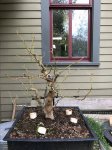If it were me I would have more of the tap root. With tridents you can be ruthless - I would have carved it all the way down until it was flush with the radial roots. Also remove the upward and downward growing roots. Then cut back the thicker roots and leave the thinner ones long.
I'm sure that people are getting tired of me saying this, but for taproot trimming, I use a 60 - 80 grit flapper disc on a 4" angle grinder. It works reasonably fast and I find that it is easier on the tree because I don't damage other parts of the tree when I'm wrestling with it and not paying close attention to what is rubbing, bending, or breaking elsewhere when I'm distracted.
I also use stainless steel lag bolts on larger trees, but you have to drill a pilot hole in the bottom of the tree first, so the trunk won't split... then you have to be sure that you seal the wound/hole well after removing the lag screw, or remove the board, re-inert the lag screw, then zip cut the bolt flush with a thin cutting disc (again, on the angle grinder)... basically, I just leave a portion of the screw in the tree.
My Manitoba Maple trees out front of the house are getting large plates at the base, because the back wheel on the lawn mower drags the dirt away from the base of the tree little by little each time I mow around them... it's interesting to see it happen, is it a natural reaction that is causing the roots to fuse, or a natural reaction causing them to swell when exposed to the atmosphere... or, is it possibly both?
Having said that, we don't have the climate for the types of maples you southern folk have, and MMs are unsuitable for bonsai for a number of reasons, so I've never tried that on a MM in a pot.





